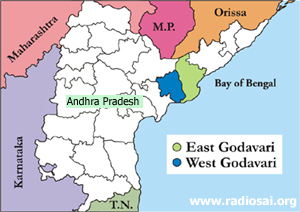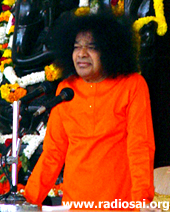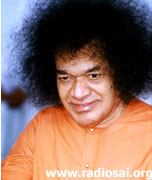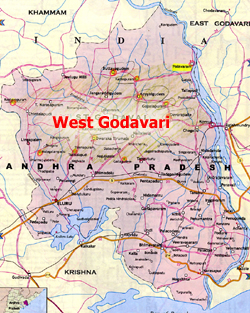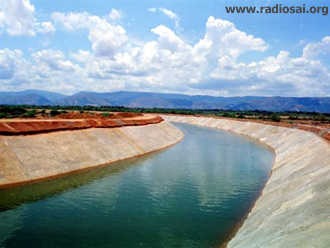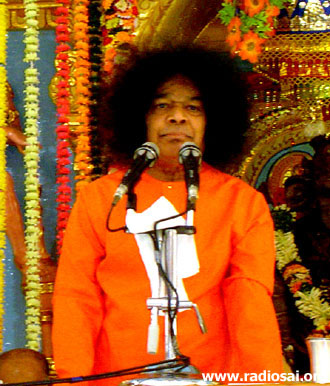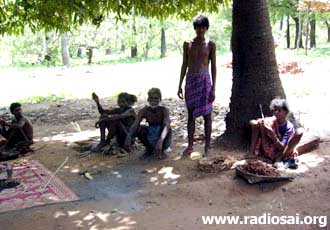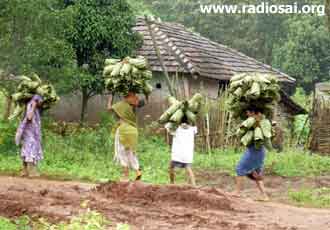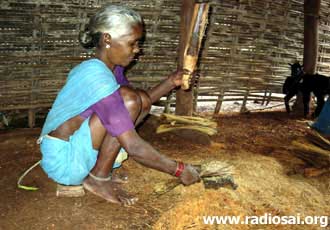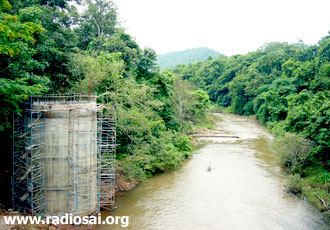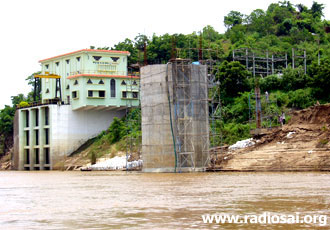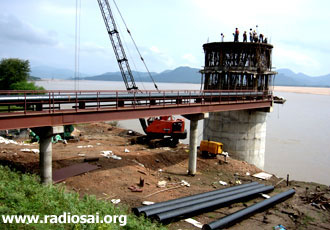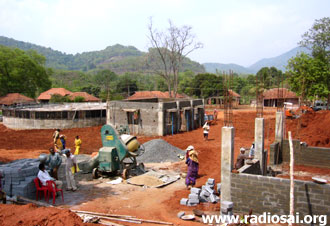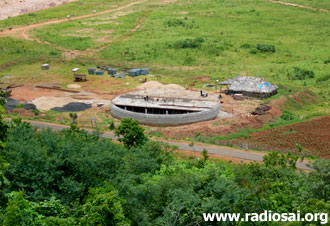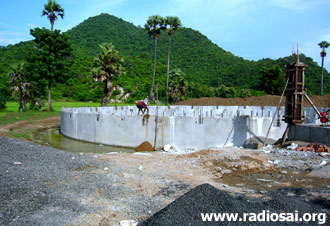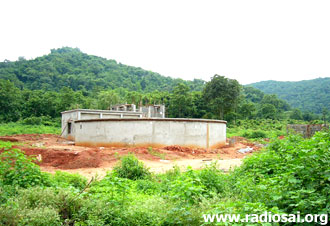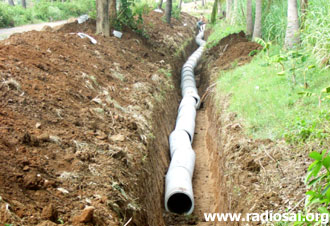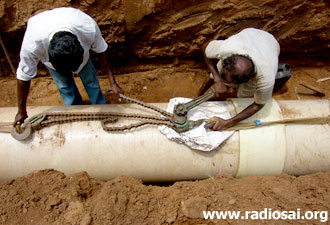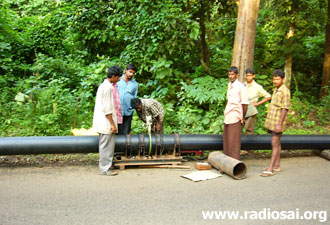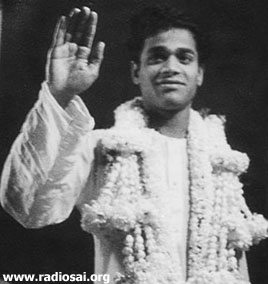 |
 |
 |
 |
| Volume
3 - Issue 12 DECEMBER 2005 |
|
THE SRI SATHYA SAI GODAVARI DRINKING WATER PROJECTYet another saga of divine love to the distressed and isolated..... |
|
In the East Godavari District especially, which is full of forests and populated largely by tribals, people living just about ten or fifteen kilometres from the river faced an acute drinking water problem. They depended mostly on borewells, most of which are drying up due to excessive use of ground water. Moreover, in some pockets, the borewell water contains harmful chemicals. In some places in East Godavari District, the tribals used to draw water from nearby streams. However, the natural water from the streams is bacteriologically unsafe. In short, for a variety of reasons, the poor people in these districts were facing difficulties.
Thus far, Swami has blessed through His many drinking water projects, the people of Anantapur District in Andhra Pradesh [where, by the way, Puttaparthi is located], then the people of Mahabubnagar and Medak Districts in north-western Andhra Pradesh, and after that the huge city of Chennai in Tamil Nadu. It is now the turn of the two Godavari Districts in the east coast of Andhra Pradesh to receive the Divine Grace of safe drinking water.
Every Sai drinking water project has its unique features. Of these, the Anantapur project, the first one to be executed, is by far the most complex. [Details of this may be found in the volume WATER: THE ELIXIR OF LIFE, which forms one of the five 80th Birthday souvenir set, blessed by Bhagavan at the time of Gurupoornima this year. You can also read our cover story on Anantapur project here]. The Chennai water project presented its own challenges and it belongs to an entirely different category. Larson and Toubro, a leading engineering construction company in India executed both the projects, and according to Mr. A. Ramakrishna, then L & T chief, the Anantapur project continues to remain the most complex water project they have executed thus far.
Although this is no different from what was done earlier in Mahabubnagar, there are, as is to be expected, some unique challenges, especially in East Godavari . The most important of this is that the target villages are located in a forest region.
Before doing any project in this area, however beneficial, clearance must first be obtained from the agency charged with environmental protection. Further, while laying pipes, no trees must be cut. Interestingly, the tribals living in the region also demand this, which of course, is good news.
Yes, Swami’s love knows no barriers. He knows who needs what and provides like a loving mother. Before we proceed with the details of the project, just a word about the tribals of this region - the main beneficiaries of the East Godavari project. The lives of the tribals in Interior East Godavari District are fully intertwined with forest and seasons. They live on forest produce. They cut the trees on the mountain slopes and cultivate pulses and some cereals which is generally called “Kondapudu Cultivation.” In the recent times, the Government has imposed certain restrictions on felling of tress and ordered that fruit yielding trees must be grown on the mountain areas cleared by tribals. They also make thin threads out of the trunk of a tree called “Thati Picchu”.
These threads (you see the lady making the threads in the picture above) have many salient properties and are an export-oriented item used for making baskets and other handicrafts. As can be seen from the above images, their living conditions are still primitive. Coming back to the project details, there are two intake wells in the East Godavari District while West Godavari has only one. The intake wells at Purushottapatnam and Pamaleru in the East Godavari District, together will cater to the drinking water needs of about 300 villages.
While the Purushottapatnam Intake Well is located on the bank of the Godavari River, the intake well at Pamaleru actually collects water from a stream which later joins the Godavari River. The stream, in the rainy season, carries a lot of water. Even in the dry season, there is always a fair amount of subsoil water to meet the needs of many neighbouring villages. In the West Godavari District the only intake well is at Polavaram. And near this intake well is the large Water Treatment Plant at Hukumpet.
Water is sent from the intake wells at the various collection stations to filtration plants where the water is filtered and purified. From there, the water is pumped out and sent through pipes to many storage tanks, from where the water is distributed to the villages.
Work started some months ago and is in full swing. It is expected to be completed by around March 2006. When completed, about five hundred villages in the two districts are expected to be benefited and about half a million people would receive Sai water to drink every single day!
Before we bring this feature to a close, there is one thing that we must draw attention to. From the late sixties, Swami has, step by step, been sending some important signals through His Missions in the area of education, health and now water. The education projects came first, starting with the establishment of the College for Women, way back in 1968. As is well known, other colleges followed, all of which were blended into a University, the Sri Sathya Sai Institute of Higher Learning. What was the underlying message? There were actually two. First, education must set character development as the primary objective. As Swami often says, the end of education MUST be character. With every passing day, especially the way things are in the world this message acquires greater and greater significance. The second message is that education must be given free, and must be a responsibility of Society as a whole. When Society takes care of all, everyone would in turn take care of Society – that incidentally is also the lesson the human body teaches us where all organs serve to keep the body alive and the body as a whole in turn takes care of the organs.
What about health? It is the same message there. If Society does not come forward to provide healthcare for all in some manner or the other, and healthcare is available only to those who can afford it, then Society would be sharply divided into the rich and the poor, the haves and the have-nots, with all the social tensions and the evils that go along with such a division. What is the use of a Society where most people are sick because they do not have the means to stay healthy? That in fact is the situation faced in many countries, especially in Africa. And it is the same with water. Water cannot be monopolised or made into a commodity that is traded. There are deep and profound issues involved and these are touched upon in the companion article, God, Man and Water which we invite your attention to.
Yes, that is Swami. He is far, far more that what He might appear to be. When we talk of Swami’s Love, let us not forget how much He loves humanity and how He who is to be served by us, is instead serving us! Should we not do something at least now about reversing the roles? - Heart2Heart Team We are grateful to B Krishna Raju, a Sai worker from Andhra Pradesh, for painstakingly documenting the Godavari Water Project in pictures as well as in video for Prashanthi Digital Studio. |
|||||||||||||||||||||||||||||||||||||||||||||||||||||||||||||||||||||||||||||||||||||||||||||||||||||||
| You can write to us at : h2h@radiosai.org |
Vol 3 Issue 12 - December 2005
|
Best viewed in Internet Explorer - 1024 x 768 resolution. |
DHTML Menu by Milonic. |

